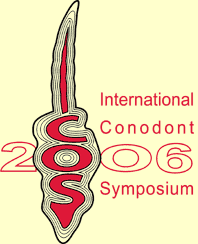 ICOS 2006
ICOS 2006
The First International Conodont Symposium
July 12 - 30, 2006.
University of Leicester, Leicester, U.K.
Page updated June 12, 2006.
Following from the highly successful series of meetings held under the ECOS banner, ICOS 2006, the first International Conodont Symposium, will be held in Leicester, UK, in July 2006. Anyone with an interest in conodonts is welcome, as are talks and posters dealing with any aspect of conodont research (details below).
| Deadlines and dates |
|
| Abstract submission |
Closed |
| Booking excursions |
Closed |
| Final booking deadline* |
June 30, 2006 |
*After June 30, registration for the meeting may still be possible, but no further bookings
for accommodation can be made. |
| Cancellations policy (link) |
|
July 12 - 16, Excursion 1 - The Carboniferous of Ireland
July 16, arrival in Leicester and evening Ice Breaker
July 17, Technical Sessions (Pander Symposium); evening reception (Sponsored by Hitachi high-technologies)
July 18, Technical Sessions (inc. Devonian Symposium; SDS business meeting during evening)
July 19, Day Excursions (see below)
July 20, Technical Sessions, Conference Banquet (Combe Abbey)
July 21, Morning - Technical Sessions, afternoon, Palaeobiology Workshop
July 21 - 27, Excursion 2 - Iapetus - from coast to coast
Registration, abstract submission and payment (by credit card) is via online forms - click here to register. Once you have setup a conference account, you will be able to edit your registration and make your payment. You will then be able to submit abstracts for oral and poster presentations. Title, authors, affillations and the abstract text are entered in separate boxes on the abstract submission page. The limit for the body of the abstract is 300 words, and the forms will not allow longer abstracts to be submitted. Like the booking forms, the abstract submission forms do not have to be completed in one go; you can save your changes and come back to the pages to edit details later. However, you may make changes to your abstract only until June 9 2006, after which time all abstracts will be be considered final. HTML tags may be used to format your abstract title and text. (Consult this HTML primer for help using these tags). More detailed instructions are contained on the abstract submission pages.
Support for attendance: A limited amount of financial support is available to assist students and other participants who would otherwise have difficulty in attending the meeting. If you think you might qualify for support, please contact the organisers (ICOS2006@leicester.ac.uk) before registering.
Registration
|
Registration includes transport between lectures and accommodation, lunches, tea and coffee, reception in Leicester New Walk Museum, ice-breaker, abstract volume, and Conference Banquet. This will be a mediaeval banquet, with drinks and entertainment, held at nearby Coombe Abbey.
|
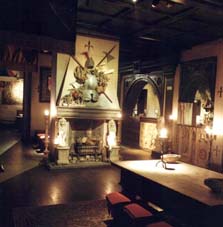
The Abbeygate Drinking Chamber, Coombe Abbey |
| Full registration £200 |
Student: £110 |
| Accompanying persons registration: £55 |
Includes reception, ice breaker, and conference banquet; does not include lunches, abstracts, or access to scientific sessions. |
Registration for Pander Symposium only: £25
Registration for Devonian Symposium only: £25 |
| Final booking deadline June 30, 2006 (after June 30, registration for the meeting may still be possible, but no further bookings for accommodation can be made). |
| Accommodation costs |
Accommodation will be in the University's Beaumont Hall residences, situated in landscaped grounds next to the University Botanic Gardens in Oadby, 3.5 km from the University Campus. Buses will be provided to transport participants to and from the University Campus at the beginning and end of each day. |
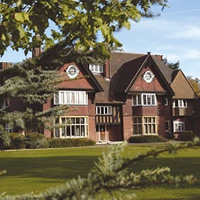
University residences, Oadby |
| Bed & Breakfast, ensuite room:
£38 per night
|
Bed & Breakfast, standard room:
£25 per night
|
| Excursion costs are indicated below |
 ICOS2006 T-shirts can be ordered when you register (£7.00) ICOS2006 T-shirts can be ordered when you register (£7.00) |
Venue, Accommodation and Travel
Leicester is centrally located in England and is easily accessible by road or rail, with good links to international airports. Maps and details of routes to Leicester are available online. For overseas participants, Birmingham and East Midlands airports are within an hour of Leicester. There are direct trains to Leicester from Stansted Airport (many budget flights from European countries fly into Stansted), and London (St Pancras Station; a little over 1 hour). For online train times, prices and booking, visit www.thetrainline.com.
Technical sessions will take place on the main University Campus, in lecture theatres adjacent to the Department of Geology. Posters will be displayed in the large foyer areas outside the lecture theatres. Tea, coffee and lunch will also be served here.
Accommodation will be in the University's Beaumont Hall residences, situated in landscaped grounds next to the University Botanic Gardens in Oadby, 3.5 km from the University Campus. Buses will be provided to transport participants to and from the University Campus at the beginning and end of each day.
Double Rooms: Please note that rooms in the University Accommodation contain one single bed. We may be able to arrange adjacent rooms in Beaumont Hall for participants who will be bringing an accompanying person, but, regretably, those who would prefer a double room cannot be accommodated and must make their own arrangements (a pdf list of hotels with prices and locations is available for download). If you make your own booking, please bear the following in mind: the conference buses will run from the halls to the campus and back and will not make other stops; evening socializing will tend to revolve around the Beaumont Hall Bar.
Evening meals: Four-course Dinner is available in Beaumont Hall each evening of the meeting, but this is not included in the Bed and Breakfast accommodation booking (dinner on Thursday takes the form of the conference banquet, included in registration fee). If you do not book dinner in Beaumont Hall, please note that the nearest shops and restaurants (in Oadby) are approximately one mile away from the Halls. Leicester City centre is approximately 2.5 miles away.
Talks and posters on any aspect of conodont related research are welcome, but in addition to open sessions the following thematic symposia are offered.
Pander's legacy, 150 years on
2006 marks the Sesquicentennial of Pander's monograph in which conodonts were described for the first time. This symposium will consider Pander and his scientific contribution, including his work on conodonts, other fossil vertebrates, and developmental biology. Keynote speakers in this symposium will include:
Professor R. J. Aldridge (Leicester), on Pander and the phylogenetic position of the conodonts - then and now
Professor Simon Knell (Museum Studies, Leicester), on Pander's contributions in their historical context and subsequent work
Professor Anthony Graham (Developmental Biology, King's College, London) on Pander's seminal work in developmental biology
Professor Peter Forey (Palaeontology, Natural History Museum) on Pander 1856 and ostracoderm vertebrates - from bits of scale to living fishes
Conodont phylogenies - alternative approaches, implications, and applications
Hypotheses of conodont phylogeny underpin many areas of conodont research, including taxonomy, biostratigraphic zonation, evolutionary palaeobiology, and analysis of the quality of the fossil record. This session will explore alternative approaches to reconstructing conodont phylogeny, their assumptions, implications and applications.
Conodonts, Palaeobiogeography and Palaeoceanography
Convened by Dick Aldridge. This session will cover all aspects of global influences on conodont distribution and the uses of conodonts in the investigation of palaeocontinental configurations, eustatic sea-level changes, climate models and the ocean/atmosphere system. Topics will include conodont biogeography, conodont geochemistry and the relationship between conodont distribution and sequence stratigraphy. Investigations of major patterns of extinction, radiation and faunal turnover will also be relevant.
Keynote: Professor Chris Barnes (Victoria University, BC) Interpreting past oceanographic, climatic and tectonic changes from conodont data.
Triassic Conodonts: Taxonomy and Time Scales
Convened by Mike Orchard. Conodonts play a primary role in Triassic biochronology and yet the taxonomic framework in which they are applied remains largely based on form taxonomic concepts. This symposium explores both the variability of taxonomic approaches currently in use in the study of Triassic conodonts, including their Permian forebears, and their application in biostratigraphy and time scales. Co-sponsored by IGCP 467, "Triassic Time and trans-Panthalassan correlations"
Keynote: Mike Orchard (Geological Survey of Canada) Triassic conodonts - the state of the art.
Constraining Conodont Palaeoecology
The classic work on conodont ecology, focussing primarily on patterns of distribution and pelagic versus benthic life habits, was largely conducted before we knew anything about the biology of conodonts. Is it time to reassess and constrain models of conodont ecology based on what we now know of their anatomy and physiology, and the nature of their fossil record?
'Coniform' conodont apparatuses and architecture - whence and whither?
Convened by Paul Smith (University of Birmingham) and John Repetski (USGS)
The last two decades have seen a major leap forwards in the interpretation of more derived conodonts, with the elucidation of apparatus architectures using natural assemblages and the use of these architectural models as templates for apparatus reconstruction in taxa unrepresented by natural assemblages. In contrast, primitive conodonts with apparatuses composed of coniform elements are poorly represented by natural assemblages and it is clear that the record is replete with partial reconstructions, and limitations created by the unknown extent of morphologically similar elements within the apparatuses of individual conodonts. Even simple questions regarding the apparatuses of these taxa have uncertain answers. How many elements were there in conodonts with apparatuses of this type? How similar was the architecture to that of primitive prioniodontid conodonts? How much variation in architecture is there within primitive conodonts? Can consistent architectural models be developed with the available assemblage data? If so, can these be used to guide apparatus reconstruction in taxa represented only by collections of isolated elements? If the phylogeny of primitive conodonts, and other aspects of their palaeobiology, are to be investigated in a secure, reproducible and testable manner, then better constrained apparatus models are essential.
Keynote: Professor Paul Smith (Birmingham University) Coniform' conodont apparatuses and architecture - whence and whither?
Devonian Conodont Biostratigraphy
Convened by Pierre Bultynck. The Devonian standard conodont zonation, mostly based on successions in deeper-water deposits, is widely used among conodont workers. However, some zones are not always easily accepted. This symposium will focus on the following topics:
Constraints on the Devonian standard conodont zonation
Alternative zonations in deeper-water facies
Alternative zonations / faunas in shallower-water facies
Graphic correlation
Keynote: Dr Sophie Gouwy - Graphic correlation as a remedy for biozone's defiencies - Application to Frasnian successions from the Eastern Anti-Atlas (Morrocco)
Workshops and Day excursions
No formal technical sessions are scheduled for Wednesday, July 19. Instead a day-long field-excursion and a visit to the collections of the NHM have been arranged. It may also be possible to provide bench space and microscopes for informal specimen based discussion, should there be demand for this (contact the organisers - ICOS2006@leicester.ac.uk).
Short Field Excursion: Lower Carboniferous, North Staffordshire.
Leaders: Patrick Cossey (University of Staffordshire) and Mark Purnell. This trip will visit two or three localities which expose Lower Carboniferous sections on the margins of the beautiful Peak District National Park. Localities to be visited will include Brown End Quarry, of early Visean age, and Cauldon Railway Cutting, of Serpukhovian age. Both localities yield some rich conodont faunas; the Cauldon fauna (which also includes abundant micro-remains of other vertebrates) was reported in Higgins (1975, Conodont zonation of the Late Visean-early Westphalian strata of the south and central Pennines of northern England. Bull. Geol. Surv. of Great Britain, 53, 1-90). There may also be opportunities to visit nearby Dovedale and the legendary Yew Tee Inn.
Maximum 50 people, minimum 20.
Cost £20.00 including lunch.
Day trip to the Natural History Museum, London.
Leader: Giles Miller. Visit one of the world's best known museums; an opportunity to go behind the scenes and examine conodont collections, including material deposited by Hinde, Higgins and large collections donated by Austin. For more information go to: http://www.nhm.ac.uk/research-curation/projects/conodonts/.
Maximum 40 people, minimum 19.
A maximum of six people can examine collections at any one time, so if you wish to examine conodont material you must let Giles Miller know what you would like to look at well in advance of the trip (email: g.miller@nhm.ac.uk)
Cost: £25.00 including lunch.
Provisional itinerary
Morning: travel by coach to Natural History Museum; arrive 10.30 approx. Split into small groups to tour micropalaeontology section.
Lunch (cold, buffet style)
Afternoon: free for visiting museum. The excursion also includes a ticket to Dino-Jaws, a visiting exhibit on Dinosaur feeding. Leave museum at 3.30 approx. returning to Leicester by coach in time for dinner in halls.
Workshop 1 Conodont Bodies and Skeletons
An opportunity to examine and discuss specimens preserving conodont soft tissues and articulated skeletons, including much of the best material from around the world.
Excursion 1: The Carboniferous of Ireland
July 12 - 16 (pre-meeting)
Leader: George Sevastopulo
Estimated cost: £140 (not including accommodation, food, Guinness etc.)
Maximum 30 people, minimum 7
Booking deadline, June 9
This field trip will focus on Mississippian (Carboniferous) rocks of the Dublin Basin and Hook Head, County Wexford. The Dublin Basin provides sections (mainly coastal) of the late Tournaisian (in a shelf/ramp setting) and all of the Visean (in both basinal and shelf settings). The basin/shelf margin is preserved and the sedimentology of both shelf and basinal carbonates (and less abundant siliciclastics) is exciting. Conodonts occur at many horizons together with foraminiferans and macrofossils. Current research activity includes identification of the Tournaisian/Visean boundary in both shelf and basinal settings. Hook Head provides a spectacular section from early Tournaisian redbeds and shallow marine carbonates and siliciclastics through progressively deeper water limestones and shales (youngest part of the Polygnathus communis carina Zone in the highest preserved beds). Conodonts from Hook Head were described by Johnston and Higgins (1981; Conodont faunas from the Lower Carboniferous rocks at Hook Head, County Wexford, Journal of Earth Sciences of the Royal Dublin Society, 4, 83-96).
Outline Itinerary
Wednesday July 12: Arrive in Dublin. Tour of Trinity College and visit to the Book of Kells for those arriving by early afternoon. Introduction to the trip in the evening.
Thursday July 13: Hook Head. Drive to Hook Head (ca. 3 hour drive). Examine Tournaisian section. Lunch at and tour of the lighthouse (see http://homepage.tinet.ie/~earrings/hook-head.html for some touristic images). More Geology. Return to Dublin.
Friday July 14 - Saturday July 15: Dublin Basin. Drive to sections in north County Dublin including Tournaisian at Malahide and Waulsortian limestone at Feltrim, late Tournaisian - late Visean shelf succession south of Skerries, Visean basinal succession between Rush and Popeshall. Opportunity to examine substantial collections of Carboniferous conodonts from Ireland and also to drink some Guinness in the evenings.
Sunday July 16: Travel to Leicester (most convenient and cheapest flight is with Ryanair to East Midlands Airport).
Accommodation
Participants will need to book their own accommodation. Below is a list of recommended accommodations, provided in rough order of cost. Trinity College Dublin rooms are available on the campus; anyone who does not want luxury should book these, but those interested should book early. The alternative TCD accommodations are out of the centre but close to the Tuas (tram) service.
Excursion 2: Iapetus - from coast to coast
July 21 - 27
Leaders: Howard Armstrong, Rob Raine & Paul Smith
Cost: £550
Maximum 30 people
Booking deadline, June 9
Cost includes coach travel, accommodation, food, and field guide. Participants are responsible for ensuring that they are insured under their own travel insurance policy. Some financial support support for students wishing to participate on this trip may be available.
| This fieldtrip will take the form of a transect across the Caledonide mountain belt of Scotland and northern England or, in palinspastic terms, a coastline to coastline traverse across Iapetus.
The trip will commence by looking at the Ordovician-Silurian succession in the Lake District, including an examination of the Ashgill in its type area. We will then cross the Scotland-England border, marking the leap from Avalonian to Laurentian crust, with the next stops at deep water Ordovician localities in the Southern Uplands, where current controversies over the tectonic interpretation of the Southern Uplands and Midland Valley terranes will be discussed. Crossing the Midland Valley of Scotland, the Neoproterozoic Dalradian Supergroup will be traversed from the Highland Boundary Fault, where obducted Ordovician ocean floor and islands with shallow water Laurentian conodont faunas can be seen at Dounans, north to the Great Glen fault and Loch Ness. We will then continue northward across the Moine thrust belt, where Neoproterozoic metasediments are thrust over the Laurentian foreland, to end the trip on the shoreline of Laurentia at the classic Cambro-Ordovician sections in Durness. In addition to providing the opportunity to sample conodont localities described by Higgins, Bergström, Ethington, Lindström, Armstrong and Orchard, the trip will also consider the history of geological exploration in this region, together with current interpretations and controversies regarding the margins of Iapetus, its constituent terranes and the final closure of the ocean in the Silurian.
The trip will traverse some of the most scenic parts of northern England and Scotland, and the majority of localities will be close to the road. Numbers will be limited to 25-30 participants and accommodation will be in a mixture of hotels and guest houses.
Come fishing across the Iapetus Ocean...
Outline itinerary
Friday July 21 (late afternoon), depart Leicester by coach, drive to Lake District, arrive at hotel around 9.00 pm
Saturday July 22, Lake District
Sunday July 23, Southern Uplands
Monday July 24, Dounans
Tuesday July 25, Loch Assynt roadside section. Stronchrubie cliff and Knockan Crag.
Wednesday July 26, Balnakeil Bay section, Durness. An t'Sron and Loch Eriboll. Drive to Inchnadamph. Drive to Edinburgh (participants who wish to fly from Inverness can be dropped-off, but they must make their own flight bookings; similarly, participants can be left in Edinburgh to make their own onward travel arrangements should they so wish).
Thursday July 27, return by coach to Leicester for those not left behind. Arrive Leicester afternoon or early evening.
|
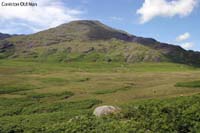
Coniston Old Man

Glencoul
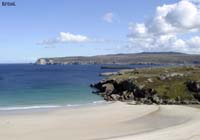
Eriboll
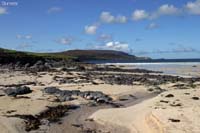
Durness
Images courtesy of Paul Smith
|
| Organisers: |
|
|
Mark Purnell
Department of Geology
University of Leicester
University Road
Leicester LE1 7RH UK
map2@leicester.ac.uk
Tel +44 116 252 3645
Fax +44 116 252 3918
|
|
Philip Donoghue
Department of Earth Sciences
University of Bristol
Wills Memorial Building
Queens Road
Bristol BS8 1RJ, UK
phil.donoghue@bristol.ac.uk
Tel +44 (0) 117 954 5440
Fax +44 (0) 117 925 3385
|
Scientific committee:
Professor Richard J. Aldridge, University of Leicester
Dr Howard A. Armstrong, University of Durham
Dr Pierre Bultynck
Dr Patrick Cossey, University of Staffordshire
Dr Philip C. J. Donoghue, University of Bristol
Dr C. Giles Miller, Natural History Museum, London
Dr Mike J. Orchard, Geological Survey of Canada
Dr Mark A. Purnell, University of Leicester
Professor George Sevastopulo, Trinity College, Dublin
Professor M. Paul Smith, University of Birmingham
|
|
Sponsors/exhibitors:
The Palaeontological Association
IGCP 467, "Triassic Time and trans-Panthalassan correlations"
Hitachi High-Technologies
Taylor and Francis (Lethaia, Fossils & Strata)
StrataData
Media Cybernetics (suppliers of Image Pro Plus image analysis software)
Qimaging (suppliers of scientific digital firewire cameras) |
 ICOS 2006
ICOS 2006





